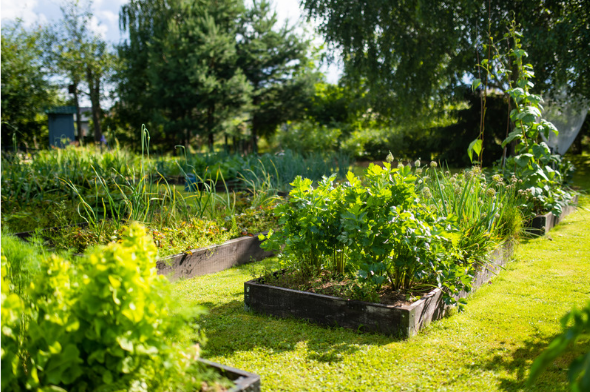For all the urban homesteading peeps out there, this post will help you protect your backyard. Some urban backyard visitors can wreak havoc on meticulously tended gardens, leaving homeowners frustrated and helpless. While it’s impossible to make your garden completely critter-proof, methods exist to minimize the impact of these predatory threats, allowing you to coexist peacefully with creatures big and small.
By understanding the delicate balance between the desire to protect your small garden and the necessity of preserving the ecosystem, you can create a sanctuary that thrives with flora and the diverse fauna that graces your backyard.
To help, we’ve put together some ingenious solutions that empower you to safeguard your small backyard oasis. It is indeed possible to harmonize with nature, appreciate the beauty of cohabitation and deter unwanted visitors without causing harm. Let’s see how.
Urban Homesteading – Tips for Critter-proofing

Nature’s clues help to tailor management methods
Creating a harmonious haven in your backyard involves selecting the right plants and flowers and understanding the intricate dynamics of the wildlife that share this space with you. The first step in tailoring your predator management methods is identifying who’s eating what.
Nature leaves behind a trail of clues for the keen observer. Tracks in the soil, pellet droppings, and holes in fruits are telltale signs that can reveal the identity of your garden intruders. Raccoons, with their dexterous paws, often leave muddy prints near vegetable patches. Deer, on the other hand, might leave distinct hoof marks and half-eaten shrubs in their wake. By studying these signs, you gain valuable insights into the habits of your wild guests.
Select plants that deter predators and beautify your garden
Some plants possess natural defenses that make them less appealing to hungry visitors. By incorporating these resilient greens into your garden, you not only enhance its beauty but also create a natural deterrent against predatory threats. Understanding the art of plant selection is akin to crafting a living armor for your backyard sanctuary.
Certain plants with features like strong aromas, fuzzy leaves, or prickles stand as guardians against ravenous wildlife. Holly and barberry are considerably less tempting to garden intruders. Ornamental grasses add a touch of elegance while remaining untouched by grazing animals. With its glossy leaves and vibrant berries, Holly symbolizes endurance against hungry birds and critters. Barberry, adorned with thorns, offers both visual appeal and natural protection.
Urban homesteading needs a sturdy fence for success
Fencing provides an effective defense and a proactive solution to keep unwanted visitors at bay. The brilliance of fencing lies not only in its ability to physically bar entry but also in its power to prevent wildlife from discovering your garden’s delectable treasures in the first place.
From day one, erecting a fence is a deterrent, creating an invisible shield that dissuades animals from even attempting to access your garden. You eliminate the temptation by denying them access from the beginning, ensuring that your plants and flowers remain untouched and undisturbed.
Installing a fence protects your garden and fosters a sense of security, allowing you to cultivate a wider variety of plants without constant worry. It transforms your garden into a sanctuary where you can relax, knowing that the delicate balance between your plants and the natural world is preserved.
Cleverly containing your compost
Compost is garden gold—a rich, nutrient-packed elixir that nurtures the soil and encourages lush, vibrant growth. However, this invaluable resource can inadvertently beckon many opportunistic visitors to your backyard. Open compost piles, while teeming with the promise of decayed organic matter, also act as an irresistible banquet for various creatures of the night.
To protect your garden and prevent these marauders from venturing further into your sanctuary, containing your compost becomes not just a choice but a necessity. A self-contained compost bin with a snug-fitting lid forms an impenetrable fortress against curious critters – simple!
By utilizing a self-contained compost bin, you not only contain potential odors but also discourage unwanted critters from accessing your nutrient-rich compost. The secured lid acts as a barrier, preventing animals from foraging through your organic matter. Additionally, it aids in managing odors that might attract unwanted attention.
Moreover, incorporating specific composting practices can help regulate the temperature and accelerate the breakdown process, making it less enticing to pests. Turning your compost regularly ensures aeration and helps maintain a balanced, healthy environment within the bin. Balancing green and brown materials in your compost helps control the odor, ensuring that the decomposition process remains efficient without inviting unwanted visitors.
Creating a composting area away from your immediate garden space can further deter wildlife from encroaching on your plants. Placing the compost bin in a discreet, well-ventilated area not only minimizes potential odors but also limits the accessibility for animals to the compost pile.
By implementing these strategies, you can continue to harness the benefits of composting while safeguarding your garden from potential predatory threats. The art of managing compost not only contributes to a thriving garden but also fosters a harmonious coexistence with the wildlife that surrounds your urban homestead.
Conclusion
With a thoughtful approach and strategic planning, it’s possible to create a harmonious sanctuary within your small backyard, safeguarding it from predatory threats without disrupting the delicate balance of the ecosystem. By understanding the behaviors of wildlife visitors, selecting the right plants, implementing sturdy fencing, and cleverly managing compost, you can establish a thriving oasis that coexists peacefully with diverse fauna.
Embracing the art of cohabitation and the principles of sustainable gardening, you can transform your urban homestead into a haven where nature’s beauty thrives alongside your carefully cultivated flora. Let your backyard become a testament to the art of balance, where the presence of wildlife enriches the tapestry of your green space without causing harm or frustration. By implementing these protective measures, you can enjoy the tranquility of your backyard retreat while ensuring its continued vitality and beauty for years to come.
Other posts you might enjoy:
Raised Bed Gardening For Beginners





